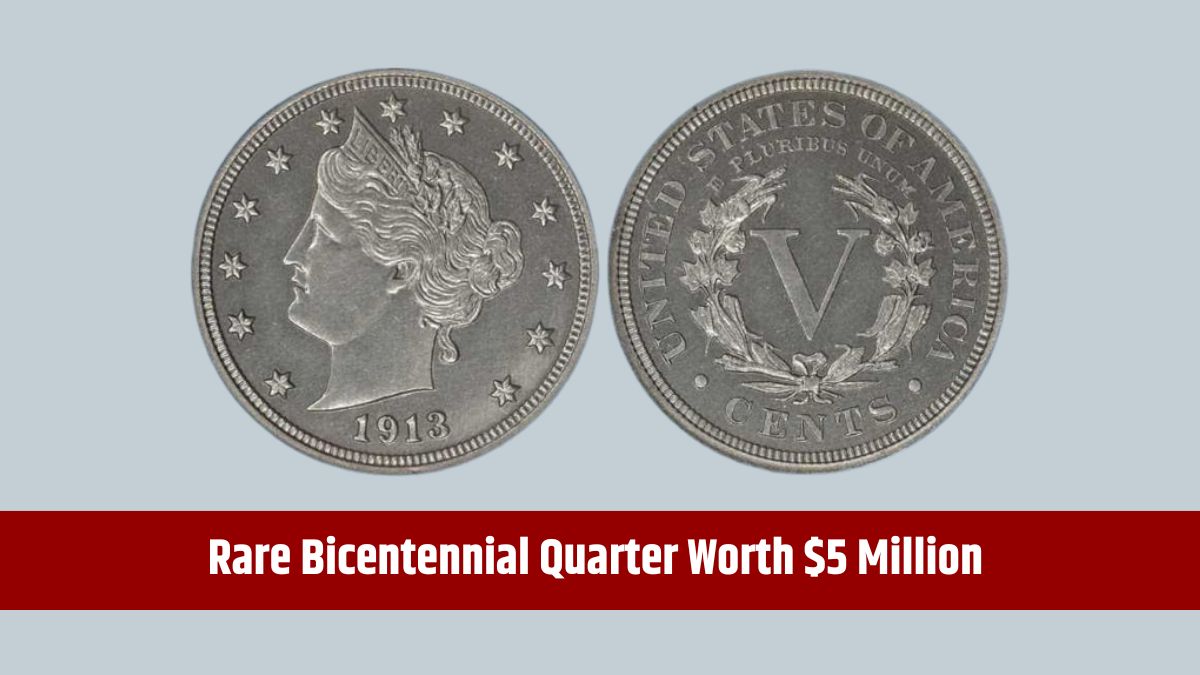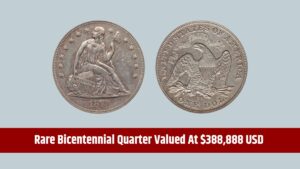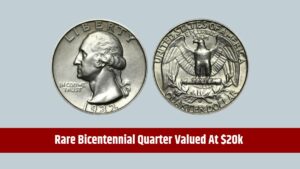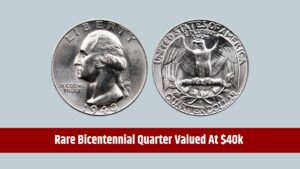The world of coin collecting is filled with treasures, some of which carry significant historical weight and extraordinary value. The Bicentennial Quarter is one such rarity, notable for its unique story and remarkable worth. Here, we look into this extraordinary quarter and six additional coins, each valued over $30 million, unveiling the captivating history and immense allure of these numismatic treasures.
Bicentennial Quarter
Introduced in 1976 to commemorate 200 years of American independence, the Bicentennial Quarter typically holds face value. However, a rare version, struck in 40% silver with a special mint mark, is valued at nearly $1 million. This unique quarter features a design of a drummer boy alongside a torch encircled by 13 stars, symbolizing the original colonies. Limited production, pristine condition, and historical significance contribute to its high value, making it a prized collectible.
| Feature | Details |
|---|---|
| Year of Release | 1976 |
| Estimated Value | Nearly $1 million USD |
| Design | Drummer boy, torch, and 13 stars |
| Significance | Commemorates U.S. bicentennial, unique silver variant |
Flowing Hair Silver/Copper
As one of the first dollar coins issued by the United States government, the Flowing Hair Silver/Copper Dollar holds a value exceeding $30 million. This historic coin, minted in 1794 and 1795, symbolizes the newly established nation and is beloved for its rarity. Its design features Lady Liberty on one side and an eagle on the other, embodying ideals of freedom and unity. Few specimens remain, making it one of the world’s most valuable coins.
| Feature | Details |
|---|---|
| Year of Minting | 1794–1795 |
| Estimated Value | Over $30 million USD |
| Design | Lady Liberty and eagle |
| Significance | First U.S. federal dollar coin, highly rare |
Double Eagle
The 1933 Double Eagle, with a face value of $20, is one of the most famous American coins, valued today at over $30 million. Due to the Gold Reserve Act of 1934, nearly all of these coins were melted down during the Great Depression, with only a few surviving examples. Featuring Liberty striding forward on one side and an eagle in flight on the other, this coin’s value is enhanced by its rarity and the intense legal battles surrounding it.
| Feature | Details |
|---|---|
| Year of Minting | 1933 |
| Estimated Value | Over $30 million USD |
| Design | Lady Liberty and eagle in flight |
| Significance | Scarcity due to 1934 Gold Reserve Act |
Brasher Doubloon
The Brasher Doubloon, minted by goldsmith Ephraim Brasher in 1787, holds a value over $30 million and is considered America’s first gold coin. Created prior to the establishment of the U.S. Mint, this coin is a symbol of the young nation’s independence. With an eagle design on the reverse and the motto “E PLURIBUS UNUM,” it reflects Brasher’s unique contribution to American coinage and has become a highly desirable piece.
| Feature | Details |
|---|---|
| Year of Minting | 1787 |
| Estimated Value | Over $30 million USD |
| Design | Eagle with shield, “E PLURIBUS UNUM” |
| Significance | First American gold coin, predates U.S. Mint |
Saint-Gaudens Double Eagle
Considered one of the most beautiful coins ever minted in the United States, the 1907 Saint-Gaudens Double Eagle is valued over $30 million. Sculpted by Augustus Saint-Gaudens at President Theodore Roosevelt’s request, this coin showcases Liberty with a torch and olive branch, with an eagle in flight on the reverse. Its high-relief design and artistry make it a numismatic masterpiece highly sought by collectors.
| Feature | Details |
|---|---|
| Year of Minting | 1907 |
| Estimated Value | Over $30 million USD |
| Design | Liberty and eagle in flight |
| Significance | Commissioned by Roosevelt, designed by Saint-Gaudens |
Liberty Head Nickel
With only five known examples, the 1913 Liberty Head Nickel is one of the rarest coins, valued at over $30 million. Minted in a year when no nickels were supposed to be produced, this coin features the head of Liberty on one side and a Roman numeral “V” on the reverse. This unintended creation and extreme rarity make it one of the most valuable coins in the United States.
| Feature | Details |
|---|---|
| Year of Minting | 1913 |
| Estimated Value | Over $30 million USD |
| Design | Liberty Head with Roman numeral “V” |
| Significance | Unauthorized minting, only five known copies |
Edward III Florin
Minted in 1343, the Edward III Florin is a rare medieval gold coin with a valuation exceeding $30 million. Bearing the royal seal of King Edward III, this coin is among the earliest gold coins produced in England. Its rarity and historical importance make it a prized item in numismatic circles, representing an extraordinary piece of medieval history.
| Feature | Details |
|---|---|
| Year of Minting | 1343 |
| Estimated Value | Over $30 million USD |
| Design | Royal seal of King Edward III |
| Significance | Rare early English gold coin, historic artifact |
These seven coins illustrate the exceptional beauty, history, and value that lie within the world of numismatics. Each piece, from America’s first gold coin to a medieval English rarity, stands as a symbol of the eras they represent and continues to fascinate collectors and historians alike.
FAQs
Why is the Bicentennial Quarter valuable?
The rare silver variant with a special mint mark can be worth nearly $1 million.
What makes the 1933 Double Eagle so rare?
Most were melted due to the Gold Reserve Act, with few surviving examples.
How many 1913 Liberty Head Nickels exist?
Only five are known, making it extremely rare.
What is special about the Brasher Doubloon?
It is considered America’s first gold coin, minted before the U.S. Mint.
Why is the Edward III Florin so valuable?
Its rarity and status as an early English gold coin contribute to its value.









